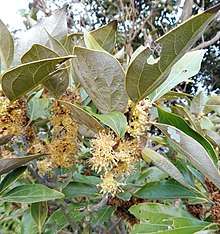Neolitsea sericea
Neolitsea sericea is a species of tree in the family Lauraceae. It is found in China, Taiwan (Orchid Island, Green Island), south Korea, and Japan.[1][2] Its natural habitat is on forest margins and slopes,[3] and it is often found in well-progressed secondary forests.[4]
| Neolitsea sericea | |
|---|---|
 | |
| Scientific classification | |
| Kingdom: | Plantae |
| Clade: | Tracheophytes |
| Clade: | Angiosperms |
| Clade: | Magnoliids |
| Order: | Laurales |
| Family: | Lauraceae |
| Genus: | Neolitsea |
| Species: | N. sericea |
| Binomial name | |
| Neolitsea sericea (Blume) Koidz. | |
| Synonyms | |
|
Neolitsea aurata (Hayata) Koidzumi | |
It is a medium-size tree, growing up to 10 m (33 ft) tall. Its leaves are evergreen, and distinctly whitened on the back. It produces yellow flowers in the fall, and its fruit is a red berry.[5]
Neolitsea sericea contains two varieties, Neolitsea sericea var. sericea and Neolitsea sericea var. aurata.[1] The latter may also be considered as its own species, Neolitsea aurata.[3]
 N. sericea
N. sericea N. sericea leaves
N. sericea leaves
References
- Liao, Jih-Ching (1996). "Lauraceae". In Huang, Tseng-chieng (ed.). Flora of Taiwan. 2 (2nd ed.). Taipei, Taiwan: Editorial Committee of the Flora of Taiwan, Second Edition. pp. 433–499. ISBN 957-9019-52-5. Retrieved 31 March 2013.
- Puhua Huang & Henk van der Werff. "Neolitsea sericea". Flora of China. Missouri Botanical Garden, St. Louis, MO & Harvard University Herbaria, Cambridge, MA. Retrieved 31 March 2013.
- Puhua Huang & Henk van der Werff. "Neolitsea aurata". Flora of China. Missouri Botanical Garden, St. Louis, MO & Harvard University Herbaria, Cambridge, MA. Retrieved 31 March 2013.
- Neolitsea sericea (in Japanese), Okayama University Plant Ecology Laboratory
- Ohwi, Jisaburo (1965). Flora of Japan. Smithsonian Institution. p. 473.
Further reading
- Chung, Myong Gi, et al. "Spatial genetic structure in a Neolitsea sericea population (Lauraceae)." Heredity 85.5 (2000): 490–497.
This article is issued from Wikipedia. The text is licensed under Creative Commons - Attribution - Sharealike. Additional terms may apply for the media files.